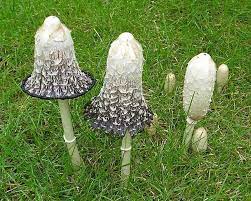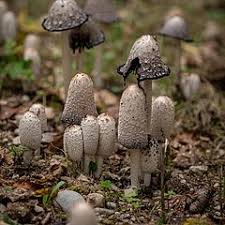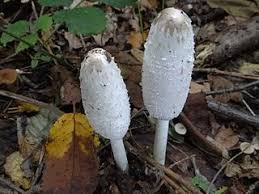Shaggy Mane Coprinus comatus
Shaggy Mane Coprinus comatus, commonly known as lawyer’s wig or shaggy mane, is an abundant fungus found on lawns and along gravel roads. The young fruit bodies first appear as white cylinders emerging from the ground before developing bell-shaped caps.
As mushrooms mature, their cap and gills liquefy due to autodigestion. This helps them disperse their spores.
Cap
Shaggy Mane Coprinus comatus is an edible mushroom commonly found on lawns, gravel roads and waste areas across North America, Mexico and Australia. It’s one of the four “Foolproof Four” mushrooms (Portabella, Lion’s Mane and Shiitake), easily identified in the field and having a long shelf life.
Shaggy mane mushrooms have a cap that is usually white to light grey in color with upturned scales that often appear tan or reddish-brown against the white background. Initially white, these gills underneath quickly turn black and ink-like after death.
Shaggy mane mushrooms are easily identified by their tightly packed gills when young. Be mindful that these gills contain coprine which may cause adverse reactions if mixed with alcohol; symptoms include flushing, nausea, headache, dizziness and palpitations.
These symptoms can be severe and last up to three days. If you experience any of them, stop drinking immediately and contact a doctor for further assessment.
As shaggy mane mushrooms grow, their cap begins to flare out slightly at the bottom and deliquesces (turns into black liquid). As the mushroom matures, its liquid content increases until only the stem remains.
When collecting shaggy mane mushrooms, it’s easy to be mistaken for the inky cap or tippler’s bane, Coprinopsis atramentaria. Both mushrooms are edible but consuming them with alcohol can lead to nausea due to coprine, which interferes with liver enzymes that break down alcohol into compounds for consumption – producing an unpleasant disulfiram-like reaction when mixed with alcohol.
The common ink cap, also known as tippler’s bane, lacks the distinctive upturned scales that distinguish shaggy mane mushrooms from other edible mushrooms. Although edible, it contains an enzyme which interferes with alcohol metabolism and may cause gastrointestinal distress and adverse reactions when combined with alcohol. Consuming this medication could potentially lead to serious heart complications and is therefore not recommended for consumption.
Stipe
 Shaggy Mane Coprinus comatus’ stipe is a long, straight and relatively smooth mushroom stem. This species of mushroom can be commonly found growing in disturbed soils around city parks, golf courses, front lawns and trail-side areas in spring and fall.
Shaggy Mane Coprinus comatus’ stipe is a long, straight and relatively smooth mushroom stem. This species of mushroom can be commonly found growing in disturbed soils around city parks, golf courses, front lawns and trail-side areas in spring and fall.
Shaggy Manes are an ideal mushroom for beginners to the mushroom world, as they’re relatively straightforward to identify. Their elongated bullet-shaped cap, brownish upturned scales and straight relatively smooth stem make them visible even from a distance. Plus they tend to congregate together in large groups so picking them can be done easily.
Gourmet edible, they make for an excellent gourmet snack, but they degrade rapidly if not eaten early enough. This is due to a unique spore dispersal technique called deliquescence which causes their caps to self-destruct after exposure to light.
Beyond just being an edible fungus, it also has numerous other medicinal uses as an herbal medicine. These include antimicrobial, antifungal and antiviral properties.
Mushrooms may help combat diseases like colds and flu by inhibiting virus development. Furthermore, these mushrooms contain compounds which regulate blood pressure, reduce inflammation and boost immunity levels.
Additionally, grape seed extract has numerous antioxidants which help safeguard against free radicals that contribute to aging and disease.
These effects were investigated by evaluating the antioxidant activities, reducing power and scavenging abilities of extracts from cap and stipe. Ethanolic extracts of the cap proved more efficient than hot water extracts, with a higher content of total phenols, flavonoids and tocopherols.
These results showed that cold water extracts had greater power to reduce power and scavenge DPPH, hydroxyl, and superoxide radicals than their hot water counterparts did. These findings suggest that separating the cap and stipe may be advantageous when processing and using this mushroom.
Shaggy Manes are not only edible but also a good source of vitamins A and D. These essential vitamins support healthy immunity and bone development. Furthermore, Shaggy Manes contain high amounts of fiber and protein which could contribute to weight maintenance.
Spores
Shaggy Mane Coprinus comatus are a dark black mushroom commonly found in parks and wooded areas across northern hemisphere.
They can be found in a range of habitats, such as disturbed grounds, lawns and pastures; as well as cultivated fields, gardens and forests. They often form dense clusters after rainfall and can often be identified by their distinctive bright orange coloring.
These mushrooms are easily recognized, being one of the “foolproof four,” or most widely recognized edible mushrooms due to their distinctive conical cap that resembles a wig or hairstyle.
Shaggy manes, despite their common name, are generally safe when harvested at their prime stage and properly cleaned. Eating them in reasonable amounts and under the correct circumstances should not pose any harm to humans; however, drinking alcohol may cause a negative reaction so it’s best to steer clear of them for this purpose.
Shaggy mane mushrooms exhibit an interesting trait known as “autodeliquescence.” This means the spores of this mushroom self-digest to release their basidiospores into the air – an interesting and natural method for controlling reproduction in these mushrooms.
Shaggy manes have an interesting trait in their stems, which have a fibrous appearance and hollow inside. These stems begin wider at the bottom and taper slightly towards the top where they attach under a mushroom cap.
Mushroom stems make an excellent natural dye and can be used to add vibrant hues to dishes or recipes. When treated with ammonia as a mordant, they take on a gray green hue while being cooked in an iron pot for added color and depth.
They can be used as a natural food dye for paper or wool. Their flavor is milder than morels or white truffles, yet still tasty enough for an occasional snack or small portion when enjoyed at the right time and amount.
Mushrooms are an excellent source of protein, vitamins and minerals when consumed in moderate amounts and under ideal conditions. Furthermore, they contain fiber which makes them a healthful food choice for people with inflammatory skin conditions.
Edibility
The shaggy mane mushroom (Coprinus comatus), also known as lawyer’s wig or maned agaric, is one of the world’s most beloved wild edible mushrooms. It can be found growing on lawns, along gravel roads and in waste areas worldwide.
This mushroom is an excellent source of potassium, calcium and iron. It also boasts a high level of vitamin A and low amounts of saturated fat. Furthermore, studies have demonstrated anti-inflammatory effects as well as strengthening the immune system.
According to research published in Phytomedicine by the University of Florida, shaggy mane mushrooms contain a protein which can kill human leukemia cells when cultured in vitro. This finding marks the first proof that this mushroom has this ability, according to researchers at the university.
Laboratory experiments revealed that the protein killed cells by interfering with an enzyme necessary for activating DNA within them. Furthermore, it prevented cells from repairing themselves and ultimately resulted in their demise.
Researchers discovered that the protein found in shaggy mane mushrooms can kill cells responsible for certain types of leukemia, including the MDA-MB-231 cell line. They believe this to be an encouraging development in cancer treatments.
Another study, conducted at the Center for Mushroom Biotechnology at Michigan State University, demonstrated that psilocybin in shaggy mane mushrooms can induce euphoria and visual hallucinations within 30 minutes of ingestion. Furthermore, this psilocybin has been known to create new neural connections within the mushroom.
Shaggy mane mushrooms are a common species that typically grows in large groups. Due to its size and shape, it’s easily identified.
It has a white cap with upturned, whitish-tan to reddish brown scales. The gills are close and free and eventually turn black in color.
Shaggy mane mushrooms should usually be harvested before they liquefy or “melt,” into a gooey, inky substance. This is an entirely natural process that occurs as the mushroom matures and disperses its spores.
Some people believe the shaggy mane mushroom can be consumed with alcohol, however this method is not recommended due to potential interactions between mushrooms and alcohol that could result in serious illness.
